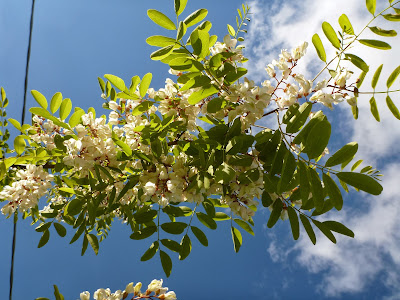Robinia pseudoacacia near Augusta Bagiennorum
It’s going on a year since we were last in Italy, May 2013. We spent two weeks in Piedmont (Piemonte), based in a small town called Villanova Mondovì (see Two Weeks in Villanova Mondovi - Off the Piemonte Tourist Track). The weather during our visit (last half of May) was good, with many days of sun. But, we were given to understand that the Spring up that point was terrible in terms of rain – too much, at least in Piedmont. Because of that, we believe, the Robinia pseudoacacia was in violent bloom everywhere we went. We got to try (for the first time) fried Robinia blossoms (“fiori d’acacia fritti”) as an appetizer, at La Marsupino in Briaglia (near Mondovì).
Robinia pseudoacacia is commonly called Black Locust and is a member of the Pea (Fabaceae) family. It is native to the southeastern United States but occurs widely in temperate locations like Italy. The tree was introduced to Europe in 1601 by Jean Robin and his son Vespasien Robin. Their name is the basis of the generic name Robinia. The specific epithet, pseudoacacia, refers to the resemblance of R. pseudoacacia to true Acacias, also in the Pea Family.
There are some fun (well for me they are) Italian botanical-themed words that are used to describe Robinia:
- eliofila [sun loving] – “La robinia o acacia è una pianta eliofila.”
- grappolo [bunch, group] – “Fiori bianchi o crema, lunghi circa 2 cm simili a quelli dei piselli, riuniti in grappoli pendenti di profumo molto gradevole.”
- polloni [suckers] – “Questa pianta emette vigorosi polloni…”
- scarpate – “…ciò ne fa un’apprezzata essenza utilizata per il consolidamento dei suoli franosi e delle scarpate.”
- inquinamento – “È pianta eliofila che resisste bene all’inquinamento atomosferico.”
- corteccia [bark] – “La Robinia ha corteccia grigio-bruna, rugosa e scanalata. I rami sono dotati di spine robuste.”
- melliferi [yielding or producing honey] – “La ricca fioritura fa della Robinia una specie di interesse non solo ornamentale, infatti i fiori sono anche melliferi.”
- chioma [foliage; crown] – “La Robinia ha portamento eretto con chioma irregolare, aperta.”
- foglioline – “Le foglie della Robinia sono composte imparipennate, lunghe 15-20 cm, formate da 4-10 paia di foglioline lunghe 3-4 cm.”
- comparire [to appear]– “I fiori della Robinia, bianchi, a grappoli profumati compaiono in maggio-luglio.”
- baccelli [pod; hull] – “I frutti della Robinia sono baccelli lunghi 5-10 cm.”
Sources for the descriptions used above:
- Alberi e boschi italiani. A site dedicated to understanding and recognizing the main species of trees in Italy. There is a page on Robinia.
- Piante e arbusti d’Italia - Robinia pseudoacacia.
- Wikipedia (it)
Robinia psuedoacacia near Augusta Bagiennorum
Robinia psuedoacacia near Villanova Mondovì
Left: Robinia psuedoacacia Description in Ciciu del Villar; Right: Fried Robinia Grappolo (Blossoms) at La Marsupino in Briaglia (Cuneo).








No comments:
Post a Comment
All comments are moderated. If your comment doesn't appear right away, it was likely accepted. Check back in a day if you asked a question.